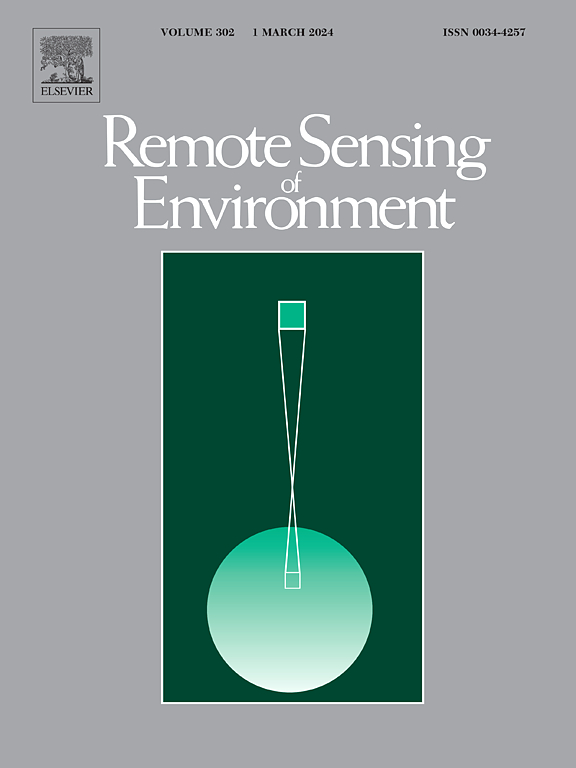Synergistic estimation of mangrove canopy height across coastal China: Integrating SDGSAT-1 multispectral data with Sentinel-1/2 time-series imagery
IF 11.1
1区 地球科学
Q1 ENVIRONMENTAL SCIENCES
引用次数: 0
Abstract
Mangrove canopy height (MCH) is a critical indicator used to evaluate blue carbon sequestration and biodiversity conservation. However, mapping MCH is challenging because of the dense tree canopy and fluctuating tide conditions. To solve the issue, this study developed a novel approach to retrieve MCH by training a robust XGBoost regression model using UAV-LiDAR, SDGSAT-1, and time series Sentinel-1 SAR and Sentinel-2 MultiSpectral Instrument imagery. The approach was applied to mangrove forests along China's coast. The study resulted in a 10 m resolution MCH map and so named China's mangrove canopy height (CMCH). The accuracy of CMCH was assessed using in-situ and UAV-LiDAR data, achieving an R2 of 0.84 and an RMSE of 1.19 m. Band 6 from SDGSAT-1, the only available 10 m resolution red edge spectral band of current available satellite data, was identified as the most crucial feature for predicting MCH. After analyzing the geographic characteristics of CMCH at species level, we had three innovative and quantitative discoveries. Firstly, the mean height of mangrove forests in China was 6.0 m, significantly lower than the global average of 12.7 m. Secondly, the height of mangrove forests in China was found to decrease with increasing latitude. Thirdly, the exotic S. apetala was identified as the tallest mangrove species in China, with the highest trees in 18.7 m along the coasts of Inner Deep Bay. To the best of our knowledge, this is the first national-scale study to investigate the geographic characteristics of MCH at species level. The resultant CMCH map and species-level findings provide essential information for managing mangrove ecosystems in China. The technical methodology employed has the potential to be expanded globally, thereby enhancing the execution of the UN's Sustainable Development Goals related to coastal and marine ecosystems. Additionally, it can contribute to the safeguarding of nature, fostering the preservation of biodiversity.
中国沿海地区红树林冠层高度的协同估算——基于SDGSAT-1多光谱数据与Sentinel-1/2时序影像的整合
红树林冠层高度(MCH)是评价红树林蓝碳固存和生物多样性保护的重要指标。然而,由于茂密的树冠和波动的潮汐条件,绘制MCH是具有挑战性的。为了解决这个问题,本研究开发了一种新的方法,通过使用UAV-LiDAR, SDGSAT-1和时间序列Sentinel-1 SAR和Sentinel-2多光谱仪器图像训练稳健的XGBoost回归模型来检索MCH。该方法被应用于中国沿海的红树林。该研究生成了10米分辨率的中国红树林冠层高度(CMCH)图,并因此命名为中国红树林冠层高度。利用原位数据和UAV-LiDAR数据对CMCH的精度进行了评估,R2为0.84,RMSE为1.19 m。SDGSAT-1的波段6是目前可用卫星数据中唯一可用的10 m分辨率红边光谱波段,被认为是预测MCH的最关键特征。在物种水平上分析了CMCH的地理特征后,我们有了三个创新的定量发现。首先,中国红树林平均高度为6.0 m,显著低于全球平均水平12.7 m。其次,中国红树林高度随纬度的增加而降低。外来种无瓣荆(S. aptala)是中国最高的红树林树种,其最高乔木高度为18.7 m,位于内后海湾沿岸。据我们所知,这是第一次在物种水平上调查MCH地理特征的全国性研究。由此得到的CMCH图谱和物种水平的发现为管理中国红树林生态系统提供了重要信息。所采用的技术方法有可能在全球推广,从而加强与沿海和海洋生态系统有关的联合国可持续发展目标的执行。此外,它还有助于保护自然,促进生物多样性的保护。
本文章由计算机程序翻译,如有差异,请以英文原文为准。
求助全文
约1分钟内获得全文
求助全文
来源期刊

Remote Sensing of Environment
环境科学-成像科学与照相技术
CiteScore
25.10
自引率
8.90%
发文量
455
审稿时长
53 days
期刊介绍:
Remote Sensing of Environment (RSE) serves the Earth observation community by disseminating results on the theory, science, applications, and technology that contribute to advancing the field of remote sensing. With a thoroughly interdisciplinary approach, RSE encompasses terrestrial, oceanic, and atmospheric sensing.
The journal emphasizes biophysical and quantitative approaches to remote sensing at local to global scales, covering a diverse range of applications and techniques.
RSE serves as a vital platform for the exchange of knowledge and advancements in the dynamic field of remote sensing.
 求助内容:
求助内容: 应助结果提醒方式:
应助结果提醒方式:


